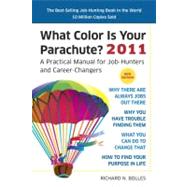What Color Is Your Parachute? has been the bestselling job-hunting book in the world for more than three decades, in good times and bad. It has sold more than 10 million copies and has been translated into 20 languages around the world.
Parachute 2011 is streamlined this year to help those struggling in these hard economic times acquire the job-search tools they need faster and more efficiently. Its life-saving information is, as always, updated and relevant to today's job market.
Career guru Richard N. Bolles leads job-hunters to find meaningful work. He asks, What skills do you most love to use? Where-in what field-would you most love to use them? And how do you find such a job without depending on agencies and ads? This book is not only about finding a job in hard times. It's about finding your passion.
“What Color Is Your Parachute is deservedly the world’s most popular job hunting book…. This 2011 edition is as relevant today as when it was first published. Dick Bolles insightfully stays on the cutting edge of job searching and the book is full of new and updated suggestions, along with the classic advice that continues to hold true today.”-Alison Doyle, About.com Job Search Guide
“If I were job hunting, I would pick up a copy of this book without hesitation.”-FOXBusiness.com, 8/25/10
“There’s Parachute, and then there’s all the rest. . . . A life-changing book.” -Career Planning and Adult Development Journal
“Parachute is still a top seller and it remains the go-to guide for everyone from midlife-crisis boomers looking to change their careers to college students looking to start one.”-New York Post
“What Color Is Your Parachute? is about job-hunting and career-changing, but it’s also about figuring out who you are as a person and what you want out of life.” -Time
“Ideally, everyone should read What Color Is Your Parachute? in the tenth grade and again every year thereafter.”-Anne Fisher, Fortune
“It was one of the first job-hunting books on the market. It is still arguably the best. And it is indisputably the most popular.” -Fast Company








